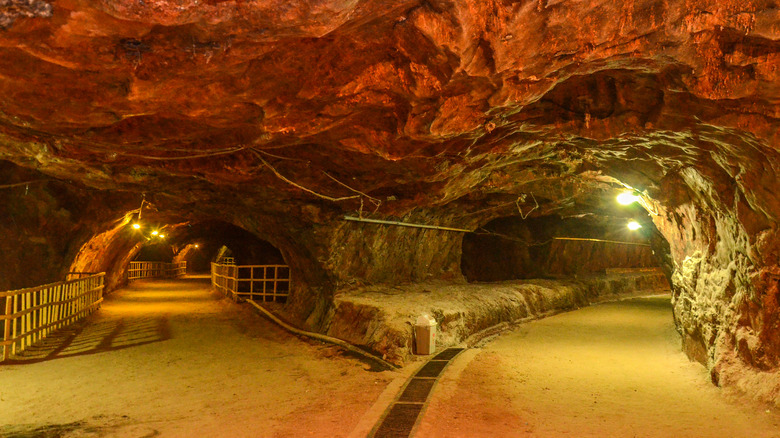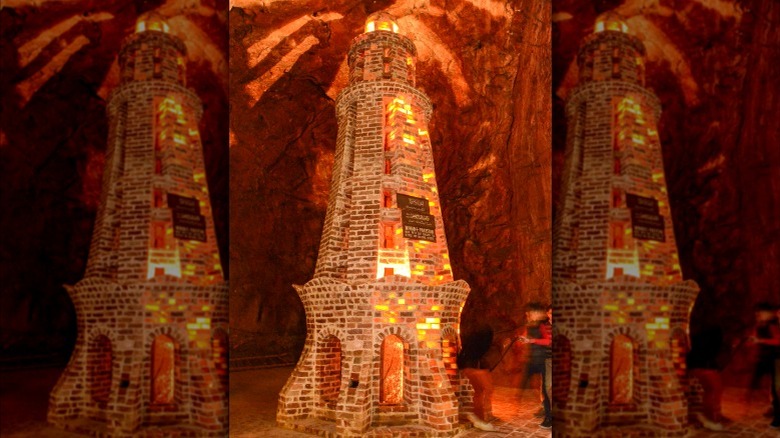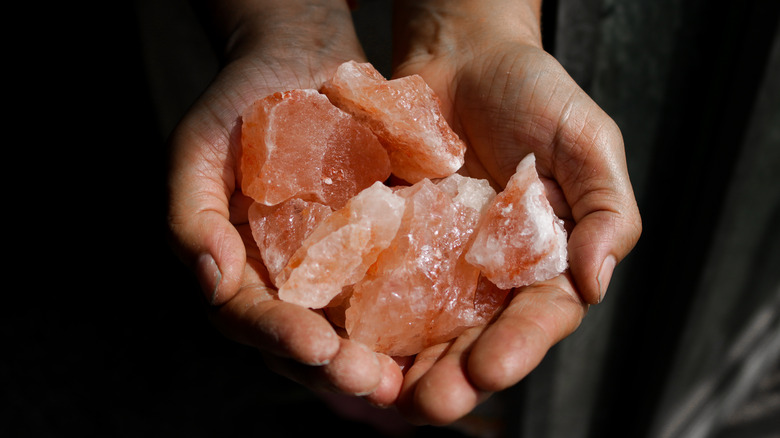The Pakistani Mine Most Of The World's Pink Himalayan Salt Comes From
Pink salt is everywhere. It doesn't take much hunting to find the eye-catching pink crystals in your day-to-day life; whether it's in your social media feed or the spice aisle of your local grocery store, Himalayan pink salt has become a legitimate phenomenon. It's used in everything from seasoning your food to cooking and serving unique dishes to lighting up your room as a decorative lamp. Many people like to tout the benefits of pink salt, claiming food is healthier and tastes better with it and that lamps can purify the air in your home and improve conditions like Seasonal Affective Disorder and insomnia (per Salt Remedy).
While Healthline notes that these theories are likely false, or at best greatly exaggerated, the gentle, aesthetically pleasing light can have relaxing effects, and The Healthy explains that the natural mineral deposits which give Himalayan salt its distinct coloring are beneficial, though they likely exist in too low a concentration to have much impact on the human body. That said, the iconic pink salt is a good, more natural alternative to processed table salt, much like sea salt, and its origin is fascinating.
An ancient mine
When most people imagine The Himalayas, they likely picture the towering snow-capped peaks of Mt. Everest and high-elevation mountain towns in India and Tibet. While pink salt does indeed come from the world's highest mountain range, mining it is probably not what people imagine. According to Business Insider, the Himalayan pink salt so many of us feature on our kitchen and bedside tables actually comes from mines 186 miles from the iconic mountain peaks
in the Punjab region of Pakistan near the base of the range where, 600 million years ago, ancient sea beds dried up leaving mineral-rich salt deposits behind. Atlas Obscura notes that Alexander the Great's army is credited with discovering the salt deposits after their horses began licking the sodium-rich ground while resting in the area. It has been mined since, though the modern operation started under British rule in the 1870s.
Business Insider explains that workers in the mines still do much of the work with hand tools, blasting away chunks of the salt cave walls and hauling out slabs of the colorful mineral, which are then either processed for food or crafted into art pieces and home décor. Four hundred thousand tons of pink salt is mined from the mountain each year from tunnels that stretch 25 miles through the Earth on 17 levels of operation. Even with centuries of mining, the workers have yet to scratch the surface of the estimated 6.7 billion tons inside.
Natural resource and tourist spot
Over the years, the Khewra Salt Mines have become more than just a massive source of the world's favorite colorful salt; they're also a notable tourist attraction. As Atlas Obscura explains, only about 50% of the salt can be removed from the mine in order to prevent the tunnels from collapsing on themselves; therefore, the rest has been carved and stacked as a makeshift support system. Over the centuries, this has led to some creative designs by miners. These include a small mosque, a crossable bridge, and a functional post office, all functional and illuminated with electricity. Saltean reports that these attractions draw about 40,000 visitors each month who tour the site on an antique mine train.
Despite serving as a thriving tourist attraction, the mine and the service it provides to the world are still under-recognized, with most people assuming the trendy pink minerals come from India, an issue that the people and government of Pakistan have attempted to remedy in recent years (per NPR).
Pakistani pride
As NPR reports, despite the popularity of Himalayan pink salt in North America and Europe, the products are rarely labeled as Pakistani. This issue began to draw attention in Pakistan in 2019, with local politicians moving to restrict trade with India and trademark the mineral as a product of Pakistan. The effort was renewed in 2021 to, as Gulf News explains, "protect it" from Indian exporters who claim it as a product of India after it is processed in their country.
NPR reports that while 400,000 tons of salt are mined in Pakistan each year, about 25% of that is exported directly to India as slabs for processing at the cost of about $40 per ton. After purchasing it at a relatively low price, Indian companies were processing the salt into products for the West and selling it at large markups while not reporting the origin of the products. When this became known in 2019, it started a social media frenzy in Pakistan, as people claimed the country was being cheated by its neighbor, with whom political tensions have always been high. Advocates argued that India could triple its salt profits by selling it directly to western countries and requiring that it be marked as a Pakistani product, which would give the nation credibility as a producer of what is considered an up-scale food product, though it would require modernizations to the country's production capabilities to bring it to western markets.



